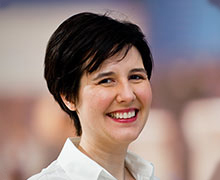Helping Teens Manage Chronic Migraines

Chronic migraine can be so debilitating for teenagers that they sometimes come into see Dr. Emily Law at Seattle Children’s Pain Medicine Clinic in wheelchairs, wearing sunglasses and headphones to block out anything that makes the pain worse. Some patients endure migraines almost every day – so often that they have trouble going to school, stop participating in sports and lose touch with friends.
Making matters worse, medication alone may not work for some youths with chronic migraine and many patients live far from providers like Law, a psychologist and researcher who teaches patients ways to reduce their pain. Now Law is preparing to study how an innovative tool – developed by her mentor, Dr. Tonya Palermo – could bridge this geographic gap by helping patients with chronic migraine over the Internet.
“Our therapies work in the clinic but many patients can’t get here,” says Law, who conducts research through the Center for Child Health, Behavior and Development. “The online tool could give those kids a chance to get back to normal life.”
Online Tool Reduces Pain
Palermo’s tool uses cognitive behavioral therapy (CBT) to teach patients (and their parents) thoughts and behaviors that reduce pain and disability. It guides participants through a series of learning modules – such as one that teaches them to relax their muscles in ways that relieve pain – and delivers weekly assignments. Participants also get feedback and guidance from an online coach. The tool reduced pain and improved disability in a preliminary study and is now in a clinical trial for children with many different types of pain.
Law is applying for a National Institutes of Health K award – a grant that helps young researchers establish their careers – to tailor the tool to adolescents with chronic migraine. The grant would help her test a version of the tool that is entirely online as well as a version where the online therapy is supplemented by telephone counseling.
Law also plans to investigate whether a screening questionnaire could identify when patients with chronic migraine have symptoms of depression, anxiety and family conflict, and when their parents have high levels of stress. This would help predict which patients might benefit from the additional telephone counseling.
“Patients who are depressed, anxious or not getting family support may have a harder time using the coping skills that we teach in treatment,” Law says. “So if we can also offer them something like telephone counseling right from the start, it could make it easier for them to learn and use these new coping strategies.”
Helping Parents Cope
Law is leading a separate, pilot study that investigates whether Problem Solving Skills Training (PSST) could help parents cope with having a child receiving intensive pain rehabilitation. Intensive pain rehabilitation programs serve children with chronic pain who are severely disabled because of their pain or who have failed outpatient treatment. Parents of these children often face serious disruptions such as missing time at work or even giving up their job to care for their child.
PSST has reduced distress among parents of children with cancer and other chronic illnesses. Palermo, Law’s mentor, developed a PSST treatment program for parents of youth with chronic pain. Palermo is evaluating this program in a clinical trial. Law is studying whether it is possible to deliver this treatment to parents of patients in the intensive pain rehabilitation programs at Seattle Children’s, the Mayo Clinic and Boston Children’s Hospital. If her study shows promising results, Law plans to apply for funding to pursue a larger clinical trial.
“Pain programs focus a lot on helping patients cope but don’t give much attention to parents,” Law says. “If we can help them too, it will make their lives better and potentially translate into better outcomes for their children.”